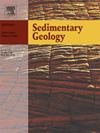泥石流中的碎屑聚集及其对泥石流动力学的影响
IF 2.9
2区 地球科学
Q1 GEOLOGY
引用次数: 0
摘要
与泥石流有关的沉积物通常由不同大小的单一碎屑组成。报道了中国江家沟泥石流中出现的一种复合碎屑,即长条形碎屑集合体。它们可以作为孤立的个体出现,更常见的是少数到数百个体的群集。2225个测量的团聚体的最大和最小尺寸分别在2至187厘米(平均17厘米)和2至107厘米(平均12厘米)之间变化。伸长比≤0.8的骨料占63%,平坦度比≤0.8的粗骨料仅占37%,且至少53%的骨料为长形球体。平均凹凸度为0.92,说明集料表面光滑。集料内部发育块状构造(有时含卵石核)、同心带状构造和变形构造。砾石由泥石流源区的滑坡碎屑和流动的泥石流浆液形成,大小从粘土到鹅卵石不等。30多个涌浪的现场观测表明,大部分砾石属于泥石流搬运的物体,翻滚过程对其发展至关重要。纤维状坡缕石是板岩基岩的成岩矿物,由板岩碎屑释放,是砾石普遍存在的原因。长团聚体的明显存在表明,泥石流可以近似为均匀的单相屈服应力流体的一维层流。泥石流中的碎屑聚集物值得注意,因为它们对泥石流动力学和促进沉积物转移具有重要意义。本文章由计算机程序翻译,如有差异,请以英文原文为准。
Debris aggregates in debris flows and implications for debris-flow dynamics
Sediments related to debris flows consist usually of single clasts of various sizes. A kind of composite debris, i.e., elongate debris aggregates, occurring in the Jiangjia Gully debris flows in China, is reported herein. They can occur as isolated individuals, and more commonly as clusters of a few to several hundred individuals. 2,225 measured aggregates vary in maximum and minimum dimensions from 2 to 187 cm (average 17 cm) and from 2 to 107 cm (mean 12 cm), respectively. The aggregates with an elongation ratio of ≤ 0.8 make up 63%, fat ones having a flatness ratio of ≤ 0.8 represents only 37%, and at least 53% of the aggregates are prolate spheroidal. The average convexity of 0.92 illustrates that the aggregate surfaces are smooth. Massive structure (sometimes with cobble cores), concentrically banded structure, and deformation structure are developed in aggregate interiors. Slate clasts ranging in size from clay to cobbles, which originate from landslide debris in the debris-flow source areas and moving debris-flow slurries, comprise the aggregates. Field observations of more than 30 surges show that most of the aggregates belong to the objects transported by the debris flows, and rolling process is essential to their development. Fibrous palygorskite, which acts as the rock-forming mineral of the slate bedrock and is released by slate detritus, is responsible for the widespread occurrence of the aggregates. The marked presence of the elongate aggregates indicates that the debris flows can be approximated as one-dimensional, laminar flow of homogeneous single-phase yield stress fluids. Debris aggregates in debris flows merit attention because of their significant implications for debris-flow dynamics and of facilitating sediment transfer.
求助全文
通过发布文献求助,成功后即可免费获取论文全文。
去求助
来源期刊

Sedimentary Geology
地学-地质学
CiteScore
5.10
自引率
7.10%
发文量
133
审稿时长
32 days
期刊介绍:
Sedimentary Geology is a journal that rapidly publishes high quality, original research and review papers that cover all aspects of sediments and sedimentary rocks at all spatial and temporal scales. Submitted papers must make a significant contribution to the field of study and must place the research in a broad context, so that it is of interest to the diverse, international readership of the journal. Papers that are largely descriptive in nature, of limited scope or local geographical significance, or based on limited data will not be considered for publication.
 求助内容:
求助内容: 应助结果提醒方式:
应助结果提醒方式:


